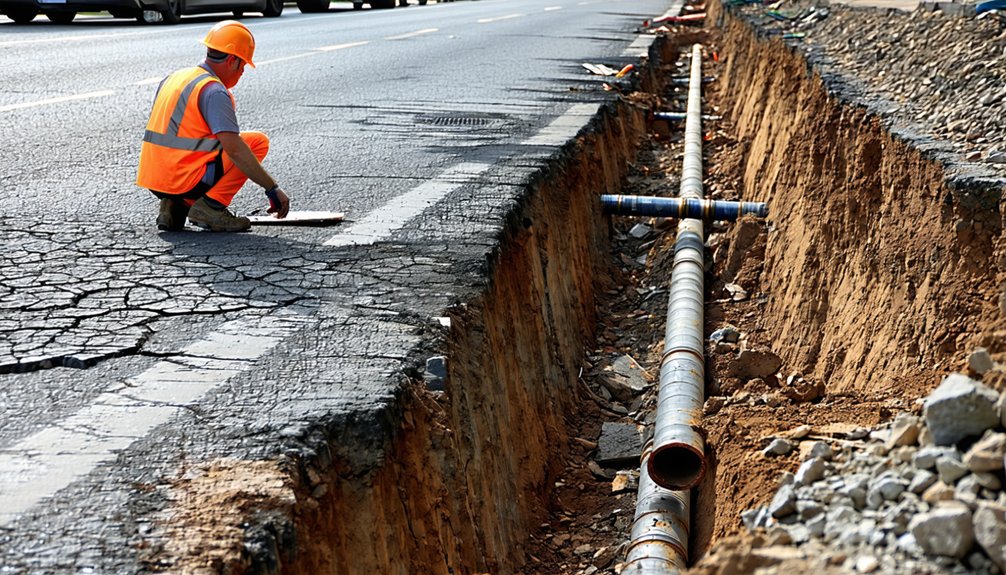Cost-effective sewer line solutions address plumbing issues by preventing minor problems from escalating into costly repairs. They facilitate efficient repairs suitable for localized issues, preserving property value and reducing the risk of health hazards. Employing modern techniques like trenchless technology minimizes disruption and landscaping damage. Additionally, informed decision-making regarding repairs versus replacements guarantees alignment with financial goals. Exploring these concepts reveals further insights into enhancing long-term property sustainability and effective plumbing management.
Understanding the Importance of Timely Sewer Line Solutions
How critical is it for homeowners to address sewer line issues promptly? Timely sewer line solutions are essential to prevent minor problems from escalating into costly repairs or replacements. Addressing signs such as foul odors or slow drainage can mitigate health hazards linked to sewage leaks. Regular maintenance and immediate attention not only preserve property value by preventing damage to landscaping and foundations but also enhance the overall reliability of the plumbing system. Engaging professional services for sewer line repair often utilizes trenchless technology, a cost-effective option that guarantees minimal disruption compared to traditional methods. Proactive sewer line solutions greatly reduce the likelihood of recurring issues, thereby curtailing future repair costs. Homeowners who prioritize timely interventions can safeguard their investments while maintaining a safe, healthy living environment. Ultimately, the prompt resolution of sewer line issues is a strategic move towards long-term property sustainability and economic freedom.
Cost-Effective Repair vs. Replacement: What You Need to Know
When evaluating sewer line issues, homeowners must consider whether cost-effective repairs or full replacements are the most appropriate solution. Understanding the pros and cons of each option is vital, especially given the age of existing sewer lines and the potential for future complications.
- Cost-effective repairs are suitable for localized problems, such as minor leaks.
- Sewer line replacement becomes necessary for severely damaged pipes, often requiring a higher upfront investment but offering long-term savings.
- Trenchless methods provide a less invasive alternative, preserving landscaping while potentially lowering overall costs.
- Professional assessments are essential to determine the ideal approach, factoring in the condition of the system.
Ultimately, homeowners should weigh immediate repair costs against the reliability of a complete sewer line replacement, leveraging specialized knowledge to make informed decisions that align with their financial goals.
Choosing the Right Emergency Plumbing Services
In the context of sewer line issues, timely intervention is paramount, necessitating the selection of appropriate emergency plumbing services. When faced with sewer line failures, certified professionals are essential for prompt and effective repairs that comply with local regulations. Evaluating potential plumbing contractors based on their response time is critical, as swift action can mitigate further damage and reduce overall costs.
Moreover, companies offering transparent pricing and detailed estimates are preferable, guaranteeing that unexpected expenses do not arise during urgent repairs. Modern techniques, such as trenchless sewer repair, should be prioritized for their efficiency and minimal disruption to property. In addition, customer reviews and ratings provide valuable insight into the reliability and quality of the services offered, enabling informed decisions. Ultimately, choosing the right emergency plumbing services guarantees effective repair and replacement methods, safeguarding the integrity of the sewer line while maintaining cost-effectiveness. Additionally, a reliable plumbing service should also provide tailored solutions for specific property needs, ensuring that sewage pump services are efficiently managed.
Frequently Asked Questions
What Is the Cheapest Way to Replace a Sewer Line?
What if the cheapest way to replace a sewer line involved less disruption and expense? Exploring cheap repair options like trenchless technology or pipe relining methods can greatly reduce costs. Homeowners might consider alternative materials usage, such as PVC, to lower expenses. Conducting a cost comparison analysis and obtaining local contractor quotes can yield valuable insights. Additionally, exploring municipal assistance programs and financing sewer projects may provide further financial relief while implementing preventative maintenance tips.
Why Is Sewer Line Replacement so Expensive?
Sewer line replacement is expensive due to several factors, including labor costs for skilled plumbers and specialized equipment. Various sewer repair options, such as trenchless technology, can mitigate expenses but still require significant investment. Factors like permits, excavation, and additional restoration costs contribute to plumbing service costs. Common sewer issues necessitate regular sewer inspection methods and plumbing maintenance tips, while emergency plumbing services and preventative measures further influence overall financial implications and environmental impact.
Does Homeowners Insurance Cover Sewer Lines?
Homeowners insurance coverage for sewer lines can vary considerably. While some policies include protection for sudden incidents, exclusions often apply to routine maintenance issues, placing homeowner responsibilities at the forefront. The insurance claim process can be complex, particularly when evaluating coverage limits and potential endorsements. Plumbing inspections and policy comparisons are essential for understanding specific sewer line policies, ensuring that homeowners are prepared for emergency repairs and aware of any exclusions that may affect their claims.
How Much Does It Cost to Install a Sewer Line?
The cost to install a sewer line varies markedly, influenced by sewer line materials, installation methods, and local regulations. Options range from $3,000 to $25,000, with trenchless technology potentially reducing excavation costs. DIY options may lower expenses, but contractor selection remains vital for quality. Maintenance tips, including pipe insulation, can prolong system life and reduce environmental impact. Cost comparisons among materials, such as PVC versus clay, further inform financial decisions for homeowners.



